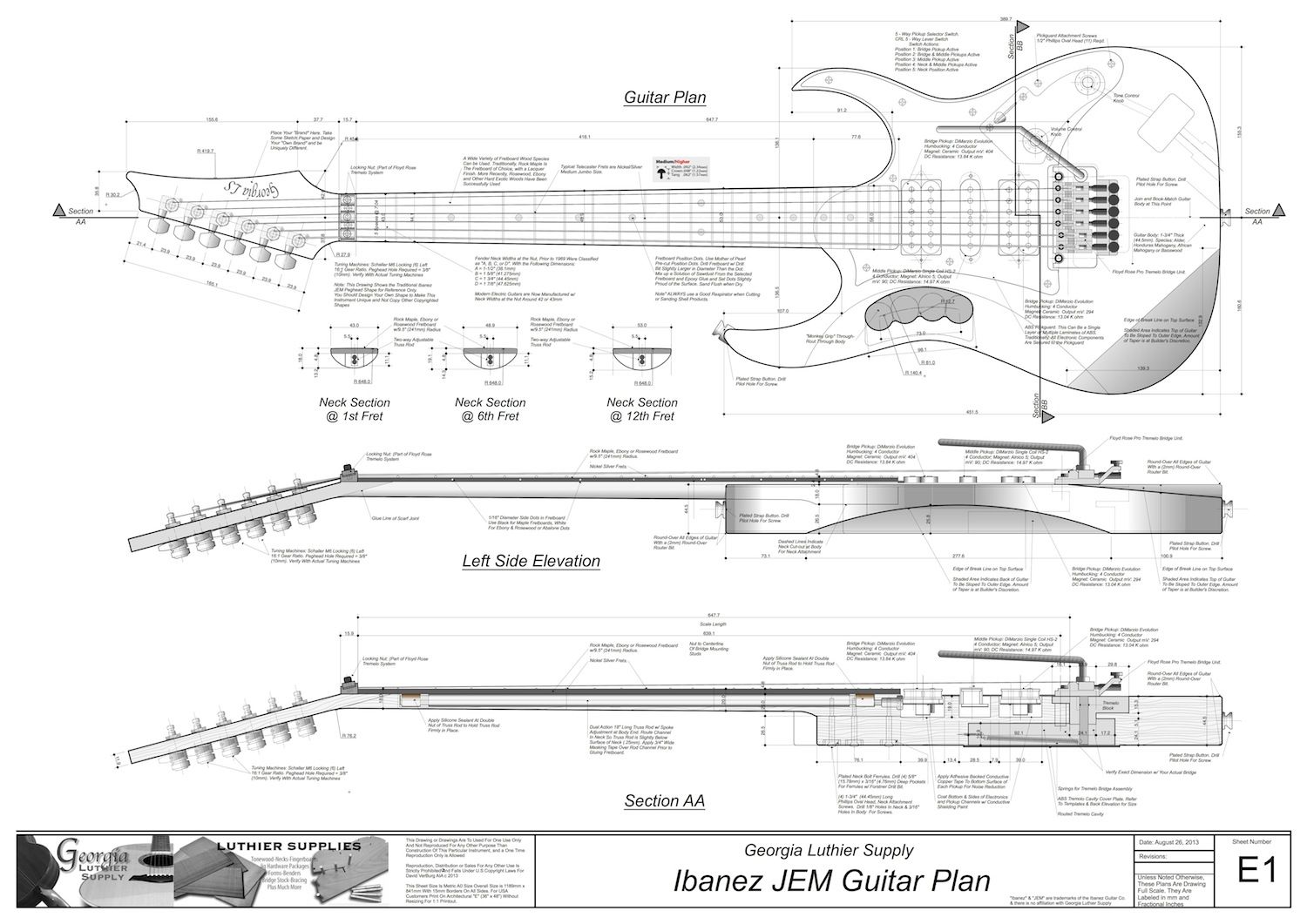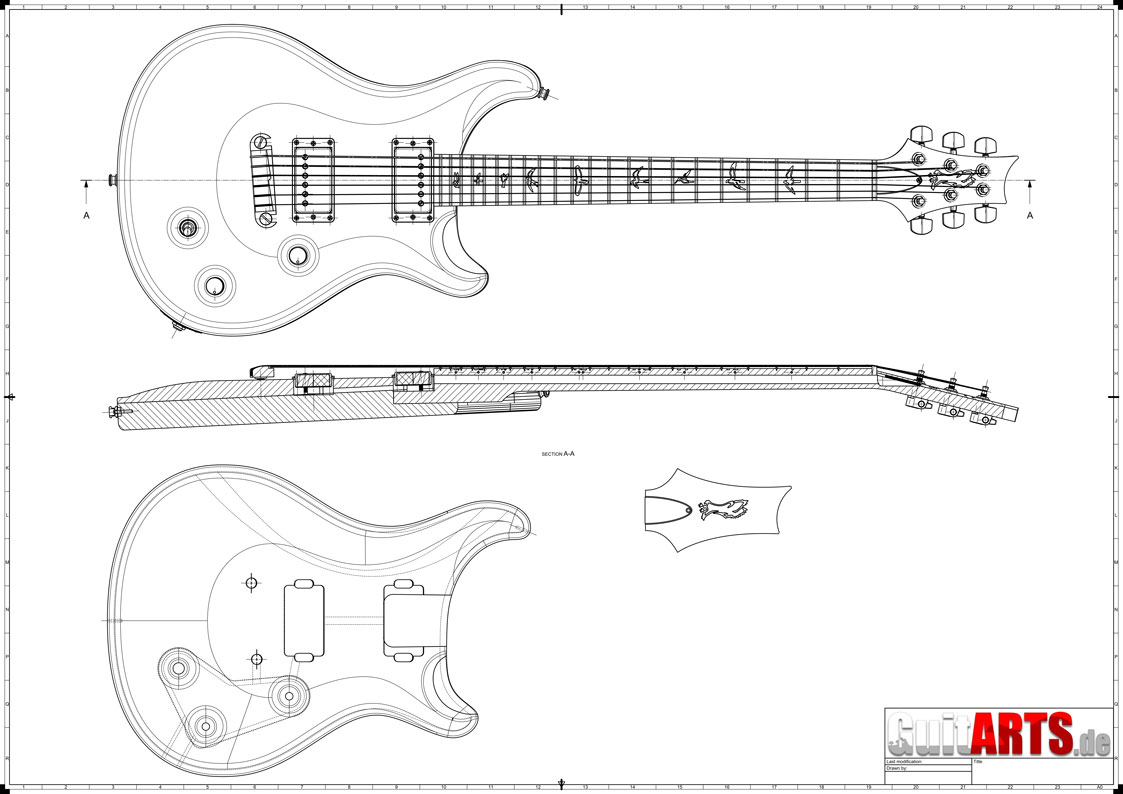

Make a point of obtaining all hardware before you start the project so there are no surprises later. While you’re building this guitar be sure to reference the hardware you plan on using when routing all the cavities. This will save you from having to buy somewhat costly fret scale templates, radiused sanding blocks and a fret slot saw. The spacing of the frets is too critical to risk. If left unfinished, maple fingerboards will quickly become dirty and stained with frequent playing.įor this project I suggest using a pre-slotted and radiused fingerboard from Stewart MacDonald. If you decide to go with a maple fingerboard it will need to be finished with a lacquer or urethane clear coat before the frets are installed. I recommend using rosewood, ebony or Ziricote.
Electric guitar plans in pdf free#
The fingerboard should be quarter sawn with straight grain, free of knots and heavy figure (an exception to this is bird’s eye maple).

Rough neck stock should be about 36″ x 5″ x 1″ and the finished thickness of the neck blank is 21mm. You may use different combinations of wood to make different patterns of laminations if you wish. A laminated neck is stiffer and more stable than a one-piece neck. You can also use flat sawn stock and laminate it to get a quarter sawn neck blank this is the method I use. Quarter sawn is best but flat sawn is also used. Neck wood needs to be straight grained and free of knots. Walnut is also used, giving a more complex acoustic-like tone. The neck is most commonly made from hard maple or mahogany. You will need two pieces of 8/4 stock for the body, at least 21″ x 7-1/2″ finished dimensions. Swamp ash is my favourite body wood due to its lightweight and great mid-range tone. Employment Opportunity / RFQ (Request for Quote).The most common body woods for electric guitars are mahogany, alder, walnut and swamp ash.Quick Navigation Musical Instrument Design and Construction Top just dont trace it and pop it on the cnc mill. the neck angle in the drawing is also totally wrong.Īt best its a loose guide for all the parts on an SG (and thats probably how it was meant to be used mostly anyway). this becomes important because the neck joint, bridge position, controls etc will be wrong. its almost as if they scaled up the whole drawing. the body is measured at nearly half an inch too wide, and over an inch too long.
Electric guitar plans in pdf pdf#
The SG in the first pdf though is out by a lot. no disrpect meant!īl69yeah, id not be to concerned with little things, as gibson themselves like to brag how each one is a little different, particularly neck profiles. My point was merely (ASSUMING correct scale and ratios) that a mm either way meant nothing in the early days. Yes, as a woodworker and NOT a machinist, I've always found wood to be very forgiving.Īs a guitar player I would agree 100% with whavever the player likes best is what s/he should strive for. Catto is one of them Steve Rowan (RIP) was another.Īnd when it comes to making a guitar that's pretty, it's a matter of taste, isn't it? I can't really fault a guy for wanting to make/buy a guitar that looks like his favorite vintage guitar. I see the effort that other people put into replicating those designs, though, and I think it's pretty cool, and pretty interesting, and I respect those guys. I guess I'm just lucky in that I like one model of electric guitar above all others, and it's not subject to the kind of analysis that some of the more iconic models endure. And when it comes to making a guitar that's pretty, it's a matter of taste, isn't it? I can't really fault a guy for wanting to make/buy a guitar that looks like his favorite vintage guitar. We are talking about building guitars here, and it's valid to discuss tenon length, for example. Still, I don't think it's snobbery for people to dissect and even reproduce vintage designs. It's more than just the "hangover effect", there really was no emphasis on the kind of exactitude that currently pervades the industry. Back in the day, so much of the work was done by hand that some rather obvious differences exist between 2 guitars of the same model made on the same day.

If not, crank up those tubes and wail.!Blaster: So true, so true. I've been around guitars since the 60's and in those days no 2 were exactly alike for lots of reasons, but suffice it to say here, the mfg specs were, uh, not quite as tight as they probably are today.If we're getting into snobbery here, then I suggest you fork over the mega bucks for a verifiable "golden oldie".


 0 kommentar(er)
0 kommentar(er)
